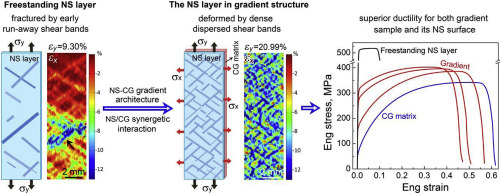当前位置:
X-MOL 学术
›
Int. J. Plasticity
›
论文详情
Our official English website, www.x-mol.net, welcomes your
feedback! (Note: you will need to create a separate account there.)
Dense dispersed shear bands in gradient-structured Ni
International Journal of Plasticity ( IF 9.4 ) Pub Date : 2020-01-01 , DOI: 10.1016/j.ijplas.2019.08.012 Yanfei Wang , Chongxiang Huang , Yusheng Li , Fengjiao Guo , Qiong He , Mingsai Wang , Xiaolei Wu , Ronald O. Scattergood , Yuntian Zhu
International Journal of Plasticity ( IF 9.4 ) Pub Date : 2020-01-01 , DOI: 10.1016/j.ijplas.2019.08.012 Yanfei Wang , Chongxiang Huang , Yusheng Li , Fengjiao Guo , Qiong He , Mingsai Wang , Xiaolei Wu , Ronald O. Scattergood , Yuntian Zhu

|
Abstract During tensile deformation, nanostructured (NS) metals often fail soon after yielding by forming a localized shear band. Here we report the observation of high density of shear bands that are homogeneously dispersed in the NS layer of a gradient Ni sample. These shear bands were nucleated at early elastic/plastic strain stage, reached number saturation at ∼3% strain, and remained arrested by the central coarse-grained (CG) matrix during the entire plastic deformation, resulting in a uniform tensile plasticity comparable to that of CG matrix. The formation of dispersed shear bands was promoted by the elastic/plastic interaction between NS surface layer and CG matrix, and affected by the surface roughness and the hardness variation in the NS surface layer. The width of shear bands remained constant, but the intensity of strain accumulation increased almost linearly with applied tensile strain, suggesting a stable shear banding process. Microstructure examination revealed that the strain in shear bands was accommodated by mechanically driven grain boundary migration and grain coarsening. These results clarify the fundamental questions: why/how does the NS layer supported by CG matrix achieve large uniform elongation? Moreover, the findings demonstrate the possibility of activating dispersed stable shear bands by synthesizing gradient architecture for optimized mechanical performances, i.e., a new strategy for evading the strength-ductility tradeoff in NS metals.
中文翻译:

梯度结构镍中的密集分散剪切带
摘要 在拉伸变形过程中,纳米结构 (NS) 金属通常会在屈服后通过形成局部剪切带而很快失效。在这里,我们报告了对均匀分散在梯度 Ni 样品的 NS 层中的高密度剪切带的观察。这些剪切带在早期弹性/塑性应变阶段成核,在约 3% 应变时达到数饱和,并在整个塑性变形过程中保持由中心粗晶 (CG) 基体阻止,导致与拉伸塑性相当的均匀拉伸塑性CG 矩阵。NS表层与CG基体之间的弹塑性相互作用促进了分散剪切带的形成,并受NS表层表面粗糙度和硬度变化的影响。剪切带的宽度保持不变,但应变积累的强度随施加的拉伸应变几乎呈线性增加,表明剪切带过程稳定。显微组织检查表明剪切带中的应变是通过机械驱动的晶界迁移和晶粒粗化来调节的。这些结果阐明了基本问题:为什么/如何由 CG 矩阵支持的 NS 层实现大的均匀伸长率?此外,这些发现证明了通过合成梯度结构来优化机械性能来激活分散的稳定剪切带的可能性,即一种避免 NS 金属中强度-延展性权衡的新策略。显微组织检查表明剪切带中的应变是通过机械驱动的晶界迁移和晶粒粗化来调节的。这些结果阐明了基本问题:为什么/如何由 CG 矩阵支持的 NS 层实现大的均匀伸长率?此外,这些发现证明了通过合成梯度结构来优化机械性能来激活分散的稳定剪切带的可能性,即一种避免 NS 金属中强度-延展性权衡的新策略。显微组织检查表明剪切带中的应变是通过机械驱动的晶界迁移和晶粒粗化来调节的。这些结果阐明了基本问题:为什么/如何由 CG 矩阵支持的 NS 层实现大的均匀伸长率?此外,这些发现证明了通过合成梯度结构来优化机械性能来激活分散的稳定剪切带的可能性,即一种避免 NS 金属中强度-延展性权衡的新策略。
更新日期:2020-01-01
中文翻译:

梯度结构镍中的密集分散剪切带
摘要 在拉伸变形过程中,纳米结构 (NS) 金属通常会在屈服后通过形成局部剪切带而很快失效。在这里,我们报告了对均匀分散在梯度 Ni 样品的 NS 层中的高密度剪切带的观察。这些剪切带在早期弹性/塑性应变阶段成核,在约 3% 应变时达到数饱和,并在整个塑性变形过程中保持由中心粗晶 (CG) 基体阻止,导致与拉伸塑性相当的均匀拉伸塑性CG 矩阵。NS表层与CG基体之间的弹塑性相互作用促进了分散剪切带的形成,并受NS表层表面粗糙度和硬度变化的影响。剪切带的宽度保持不变,但应变积累的强度随施加的拉伸应变几乎呈线性增加,表明剪切带过程稳定。显微组织检查表明剪切带中的应变是通过机械驱动的晶界迁移和晶粒粗化来调节的。这些结果阐明了基本问题:为什么/如何由 CG 矩阵支持的 NS 层实现大的均匀伸长率?此外,这些发现证明了通过合成梯度结构来优化机械性能来激活分散的稳定剪切带的可能性,即一种避免 NS 金属中强度-延展性权衡的新策略。显微组织检查表明剪切带中的应变是通过机械驱动的晶界迁移和晶粒粗化来调节的。这些结果阐明了基本问题:为什么/如何由 CG 矩阵支持的 NS 层实现大的均匀伸长率?此外,这些发现证明了通过合成梯度结构来优化机械性能来激活分散的稳定剪切带的可能性,即一种避免 NS 金属中强度-延展性权衡的新策略。显微组织检查表明剪切带中的应变是通过机械驱动的晶界迁移和晶粒粗化来调节的。这些结果阐明了基本问题:为什么/如何由 CG 矩阵支持的 NS 层实现大的均匀伸长率?此外,这些发现证明了通过合成梯度结构来优化机械性能来激活分散的稳定剪切带的可能性,即一种避免 NS 金属中强度-延展性权衡的新策略。











































 京公网安备 11010802027423号
京公网安备 11010802027423号